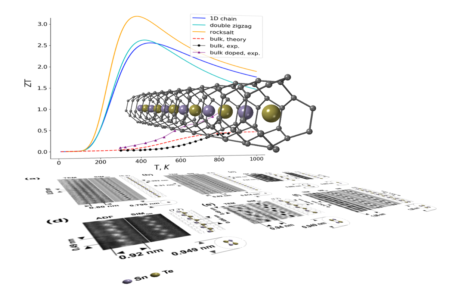Jun
6
New research at the University of Warwick shows waste heat can be converted to electricity more efficiently using one-dimensional nanoscale materials as thin as an atom. This suggests there may be a new way of generating sustainable energy.
Led by Drs. Andrij Vasylenko, Samuel Marks, Jeremy Sloan and David Quigley from Warwick’s Department of Physics, in collaboration with the Universities of Cambridge and Birmingham, the researchers have found that the most effective thermoelectric materials can be realized by shaping them into the thinnest possible nanowires.
The group’s paper has been published in the journal ACS Nano.
Thermoelectric materials harvest waste heat and convert it into electricity – and are much sought-after as a renewable and environmentally friendly sources of energy.

This is a diagram showing one-dimensional nanowires conducting waste heat to electricity. Image Credit: University of Warwick. Click image for the largest view.
Dr. Andrij Vasylenko, from the University of Warwick’s Department of Physics and the paper’s first author, commented, “In contrast to 3-dimensional material, isolated nanowires conduct less heat and more electricity at the same time. These unique properties yield unprecedented efficiency of heat-to-electricity conversion in one-dimensional materials.”
The researchers – which included the group of Dr. Andrew J. Morris from the University of Birmingham – were investigating the crystallization of tin telluride in extremely narrow carbon nanotubes used as templates for the formation of these materials in their lowest dimensional form.
In a combined theoretical-experimental research, they were able not only to establish a direct dependence between the size of a template and a resulting structure of a nanowire, but also to demonstrate how this technique can be used for regulation of the thermoelectric efficiency of tin telluride formed into nanowires 1-2 atoms in diameter.
First author Dr Vasylenko is excited about what this research could lead to said, “This opens up an opportunity for creation of a new generation of thermoelectric generators, but also for exploration of alternative candidate materials for thermoelectrics among abundant and non-toxic chemical elements.”
With a growing demand for both miniaturization and enhanced efficiency of thermoelectrics, nanostructuring offers a viable route for targeting both objectives.
This looks like a new take on thermoelectric. For all the excitement its still too soon to how well these work versus the existing technology that is charging ahead in the meantime.
Its is encouraging to think that some technology competition is going to get underway for thermoelectric harvesting. Modern living lets most of the energy used simply get away. Thermoelectric could be the energy industry of the near future by about doubling the work accomplished by the same energy used.
Comments
2 Comments so far


Great breakthrough! Energy is an eternal issue for modern human society. If this technique can be used widely in some relevant industry, it will be a good thing for the planet.
Everything is more efficient and a thousand times more expensive when you work at a nano-scale. Having a thousand times more surface area makes things happen. We get it.
But – it does not scale up because costs are almost always prohibitive.